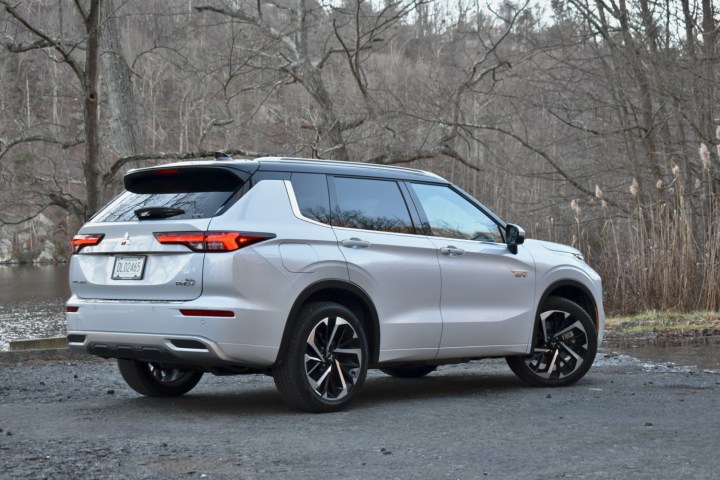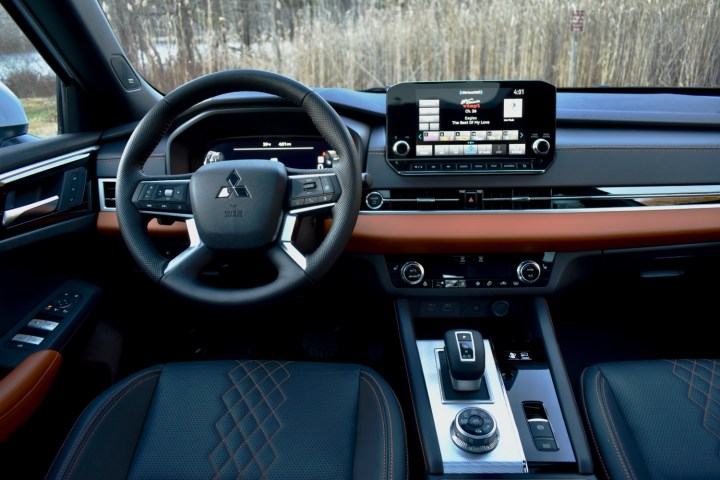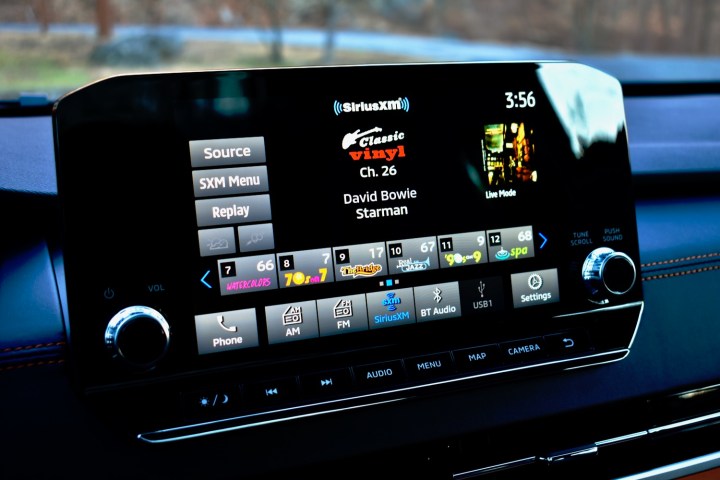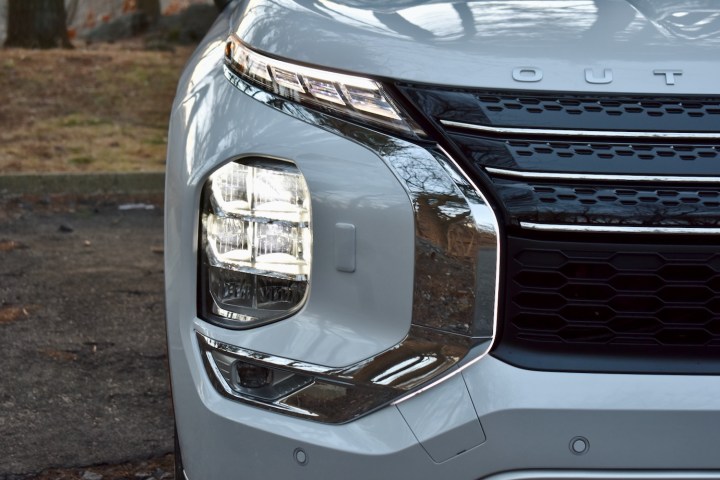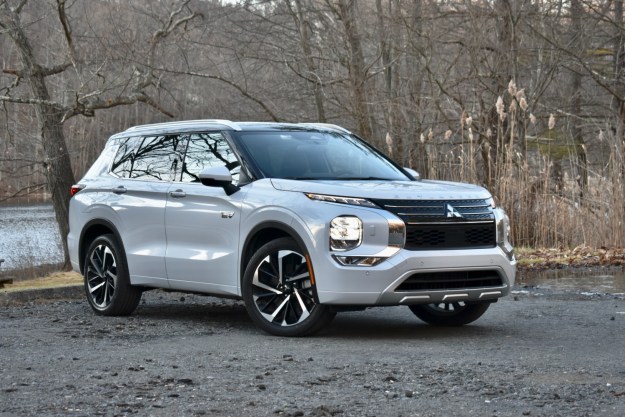
- Tough-looking exterior
- EV-like power delivery
- True SUV driving position
- Plenty of cargo space
- Lackluster infotainment system
- Poor ride quality
- Questionable value
Mitsubishi hasn’t been much of an automotive trendsetter lately, but it certainly hit on something good with the Outlander PHEV, or plug-in hybrid electric vehicle. Launched in 2017, the first-generation Outlander PHEV put an efficient plug-in hybrid powertrain in a small crossover SUV body for mass appeal. It was such a good idea that many rival automakers copied it, creating more competition for the redesigned 2023 Mitsubishi Outlander PHEV.
Where the first-generation model was in a class of one, the new Outlander PHEV must compete with plug-in hybrid versions of popular crossovers like the Ford Escape, Hyundai Tucson, Kia Sportage, and Toyota RAV4. But where competitors view their plug-in hybrids as amped-up versions of their hybrid SUVs, Mitsubishi tried to make the Outlander PHEV a bridge to all-electric cars, with an emphasis on EV-like driving dynamics.
That EV-like experience comes at a high price, though. The Outlander PHEV is available in ES, SE, SEL, and 40th Anniversary Edition trim levels, with the base ES starting at $41,190. With a few options, our SEL test car had a $50,880 sticker price, which was surprising, given Mitsubishi’s recent turn as a value-oriented brand. There’s still a lot to like about the Outlander PHEV, though.
Design and interior
Aside from some subtle badging, the PHEV model is identical to the gasoline Outlander, which was redesigned for the 2022 model year. Sharing underpinnings with the Nissan Rogue from Mitsubishi’s partner brand, this generation of Outlander features brawny, tough-looking styling that’s sure to please SUV shoppers, without resorting to the faux off-roader look of competitors like the Toyota RAV4. With its big grille, stacked headlights, and optional 20-inch wheels, our test car had serious presence.
Part of that presence comes from the Outlander’s generous proportions. While still considered a compact crossover SUV, the current-generation Outlander is longer and wider than before. It feels like a proper SUV from behind the wheel, with a commanding driving position that lets you look down on econobox drivers. Well-placed mirrors mean that the truck-like driving position doesn’t compromise outward visibility, however.
The Outlander features brawny, tough-looking styling that’s sure to please shoppers.
At 33.5 cubic feet with the second-row seats in place and 78.5 cubic feet with the second-row folded, cargo space is competitive with rival plug-in hybrid crossovers. The Outlander PHEV is the only vehicle in its competitive set to offer third-row seating, but Mitsubishi admits the cramped third is only for occasional use. Just unfolding it is a process, involving a dance of tab pulls and seat-element sliding. If you want a real three-row plug-in hybrid, the Kia Sorento PHEV and Chrysler Pacifica Hybrid are better options.
Like the exterior, the interior has a distinctive design that sets it apart from the many crossovers on the market. We liked the minimalist look of the dashboard and the substantial feel of the steering wheel, which had thick girder-like spokes that matched the vibe of the exterior, as well as our test car’s brown-and-black two-tone leather upholstery. Yet while it was well-equipped, with features like front seat massagers, a panoramic glass roof, and a built-in outlet that can use power from the battery pack to run your devices, material quality felt a step below the as-tested price.
Tech, infotainment, and driver assist
The PHEV model gets the non-hybrid Outlander’s 12.3-inch digital instrument cluster as standard equipment, plus an 8.0-inch infotainment touchscreen. Higher trim levels gate a 9.0-inch touchscreen and wireless smartphone charging. Our test car also had the SEL Premium Package, which adds a 10.8-inch head-up display and a nine-speaker Bose audio system.
Even with those extras, the tech level didn’t match our test vehicle’s price point. While Mitsubishi does offer wireless Apple CarPlay, Android Auto still requires a cable. The touchscreen is also fairly small, considering the as-tested price. The cluttered menus aren’t very attractive either, although the instrument cluster’s barrel-style gauge renderings were at least different.
Mitsubishi’s relationship with Nissan means it can borrow the latter’s ProPilot Assist tech, which gets rebranded as Mi-Pilot Assist. This is a driver-assistance system that basically adds automated lane centering to adaptive cruise control, allowing the car to accelerate, brake, and steer automatically on highways, but with the driver still keeping their hands on the wheel.
The tech level didn’t match our test vehicle’s price point.
The Outlander PHEV doesn’t get an equivalent to the more sophisticated ProPilot Assist 2.0 available in Nissan models like the all-electric Ariya, which allows for limited hands-free driving. That leaves you with about the same level of capability as systems from many other mainstream brands, with no discernible edge in performance. The Outlander PHEV was able to follow lanes most of the time, but occasionally wandered close to one side or the other — typical behavior for this tech.
We also had some issues with the execution of the more basic system in this Mitsubishi. We accidentally deactivated the assist several times while trying to flip the steering wheel toggle switch up to increase speed — a problem we haven’t noticed in Nissan vehicles, which use a similar control setup. Canceling assist means you need to press the green Mi-Pilot button and then reset the speed using a second button. Not exactly a smooth process.
Beyond Mi-Pilot, the Outlander PHEV’s list of driver-assist features is pretty comprehensive, encompassing lane-keep assist, lane-departure warning, traffic sign recognition, automatic high beams, forward collision warning, front and rear automatic emergency braking, and a driver-attention monitor. A 360-degree camera system is also standard on all but the base ES trim level, and you can pull up the camera view with a single press of a button, instead of digging through touchscreen menus, as other automakers force drivers to do.
Driving experience
Instead of the usual plug-in approach that entails simply enlarging the battery and motors from a standard hybrid, Mitsubishi designed a PHEV-specific setup for the Outlander that relies more heavily on electric power.
Up front, a 2.4-liter gasoline four-cylinder engine and electric motor drive the front wheels through a single-speed transaxle. A second electric motor drives the rear wheels for all-wheel drive, while a 20.0-kilowatt-hour battery pack supplies power. This is the same layout as the previous-generation Outlander PHEV, but the pack is now larger (it was 13.8 kWh before) and the electric motors are more powerful. The front motor now produces 113 horsepower and the rear motor makes 134 hp, up from previous outputs of 80 hp and 70 hp, respectively.
Peak output with gasoline assistance is 248 hp and 332 pound-feet of torque. That’s a bit behind the 261-hp Hyundai Tucson and Kia Sportage plug-in hybrids, as well as the 302-hp Toyota RAV4 Prime, but still plenty. More importantly, the Outlander delivers its power more like an EV than a hybrid. The motors provide most of the thrust, with the gasoline engine acting more like a generator, not unlike the defunct Chevrolet Volt. That not only provides smooth acceleration but also makes it easier to drive on electric power without the gasoline engine kicking on.
Mitsubishi also provides a number of different drive modes. First off, you get Normal, EV, Save, and Charge modes to determine when you want to use electric power. Normal mode lets the car decide, EV defaults to electric power (but still wakes up the gas engine if you press the pedal hard enough), Save reserves electric range for later use, and Charge essentially turns the engine into a generator to continuously charge the battery pack. This won’t replace plugging in, but we still found it handy for getting a head start on charging. On one trip, Charge mode added an indicated eight miles of electric range in about 20 minutes of driving.
The Outlander delivers its power more like an EV than a hybrid.
Next, you can use a dial to choose different modes for the Super All-Wheel Control (S-AWC) system. Named after the tech that gave the legendary Mitsubishi Lancer Evolution its handling prowess, S-AWC determines how the power is distributed to the wheels. Three modes (Eco, Normal, Power) manage the mix of gasoline and electricity, and four (Tarmac, Gravel, Snow, Mud) aim to maximize traction on different surfaces. We actually found Eco mode to be fine for around-town driving, while Power mode was useful for overtaking. The handling-focused Tarmac mode dialed up the handling precision, but not the fun. The Outlander PHEV is no Lancer Evolution.
Like other plug-in hybrids, the Outlander PHEV relies on regenerative braking to recover energy when decelerating. Mitsubishi chose a fairly high level of regeneration, allowing drivers to avoid using the brake pedal most of the time. Regeneration won’t bring the Outlander PHEV to a complete stop though, and that’s intentional. Mitsubishi believes allowing the car to creep forward a bit is helpful when parking, but the implementation is sloppy. We were troubled by the way regenerative braking would abruptly cut out just as we were preparing to stop, which made it hard to be smooth.
The only other issue we noticed had nothing to do with electrification. The suspension absorbed bumps well, but still allowed a lot of bouncing and lateral body motion. The Outlander PHEV never felt settled, degrading ride comfort and canceling out much of the benefit of the S-AWC system. This is one area of the Outlander PHEV that could definitely use a rethink.
Range, charging, and safety
Mitsubishi estimates 38 miles of electric range with an efficiency rating of 64 MPGe combined, and 26 mpg combined fuel economy on gasoline. With regular charging, we managed to beat that, achieving an indicated 31-mpg average, along with electricity usage of 2.2 miles per kWh. Electric range is slightly more than the Hyundai Tucson and Kia Sportage plug-in hybrids, but less than the Toyota RAV4 Prime’s 42 miles. The Ford Escape also gets 38 miles, but it only has front-wheel drive.
The Outlander PHEV is also the only vehicle in its competitive set to offer DC fast charging. It can handle up to 50 kilowatts, which can charge the battery pack to 80% in 38 minutes, according to Mitsubishi. However, the Outlander uses the less-common CHAdeMO connector, so finding a compatible charging station may be difficult. With 240-volt Level 2 AC charging you’re looking at about 6.5 hours to top up the battery pack.
The Insurance Institute for Highway Safety (IIHS) hasn’t published crash-test ratings for the 2023 Outlander PHEV, but it did give this model the top “Good” headlight rating and the top “Superior” rating for front-crash prevention tech in vehicle-to-vehicle and daytime vehicle-to-pedestrian scenarios. The National Highway Traffic Safety Administration (NHTSA) hasn’t published any safety ratings for the 2023 Outlander PHEV.
Mitsubishi offers generous warranty coverage, including a 10-year, 100,000-mile, powertrain warranty and a five-year, 60,000-mile, new-vehicle limited warranty, matching the terms of perennial leaders Hyundai and Kia. The battery pack and other plug-in hybrid system components also get their own 10-year, 100,000-mile, warranty.
How DT would configure this car
To get all of the available tech features, you’ll need to spec an Outlander PHEV like our SEL test vehicle. Just getting the larger touchscreen, wireless smartphone charging, and Mi-Pilot Assist requires upgrading from the base Outlander PHEV ES to the SE trim level. The head-up display and Bose audio system are only available as part of the Premium Package for the Outlander PHEV SEL. You won’t get a federal tax credit to soften the blow, either, as the Japan-assembled Outlander is ineligible under the latest rules.
Even the base model isn’t price-competitive with other plug-in hybrid crossovers. It’s undercut by the Hyundai Tucson Plug-In Hybrid and new-for-2023 Kia Sportage PHEV, as well as the Ford Escape Plug-In Hybrid, although the Ford lacks all-wheel drive. At $42,925, the Toyota RAV4 Prime starts $1,735 higher than the Outlander PHEV, but the RAV4 offers more electric range and more power.
None of these plug-in hybrids offer a driving experience like this Mitsubishi, though. Thanks to a powertrain that emphasizes electric propulsion and DC fast charging that lets drivers make better use of it, the Outlander PHEV is a great stepping stone to all-electric driving. Instead of being a reduced-guilt version of a crossover like its rivals, the Outlander shows drivers what to expect from an EV, while still providing the added convenience of gasoline power.
Despite a few missteps — including poor ride quality, an unimpressive infotainment system, and afterthought third-row seats — the Outlander PHEV is also a good crossover in its own right, providing the style and utility customers expect from these vehicles. The price may be hard to swallow, but no other vehicle offers this combination of traditional crossover attributes and an EV-like driving experience.

